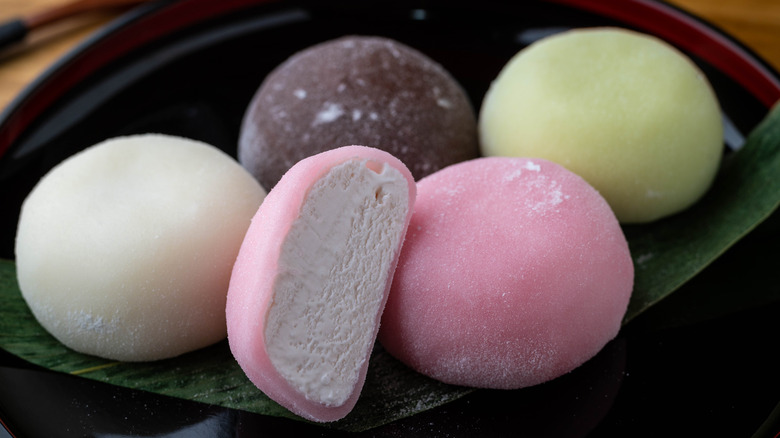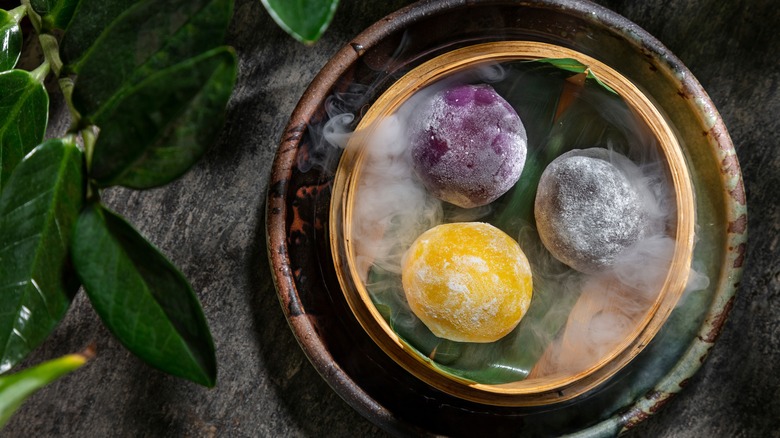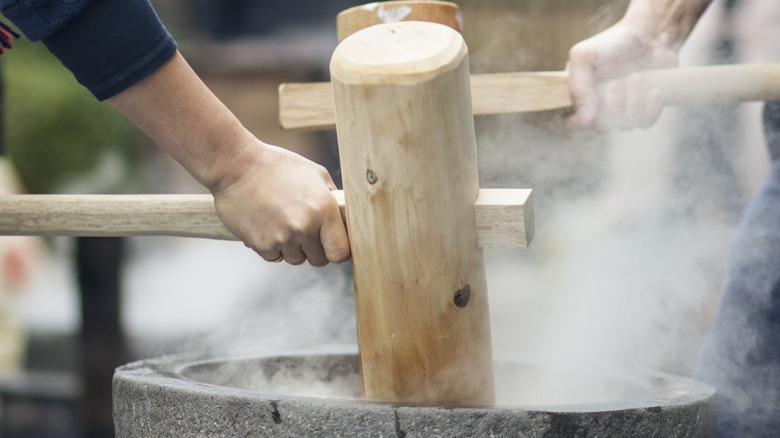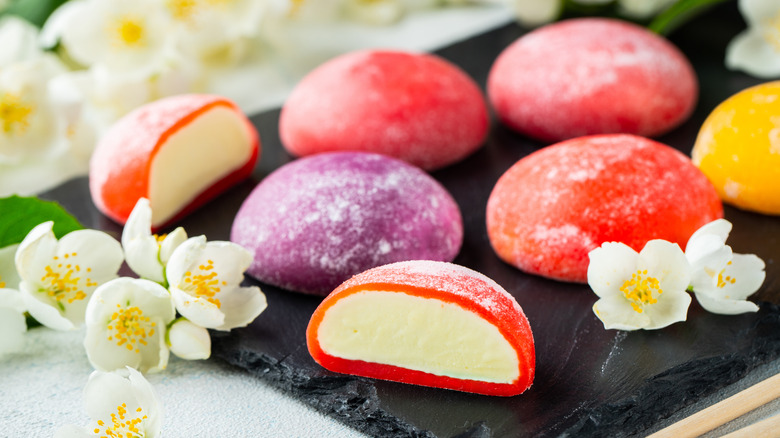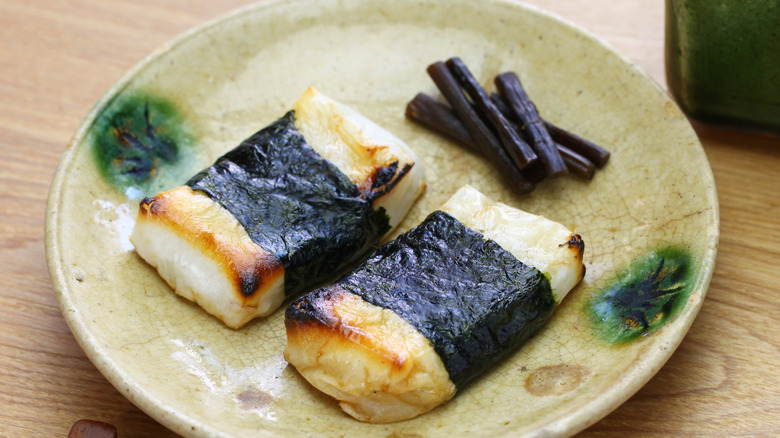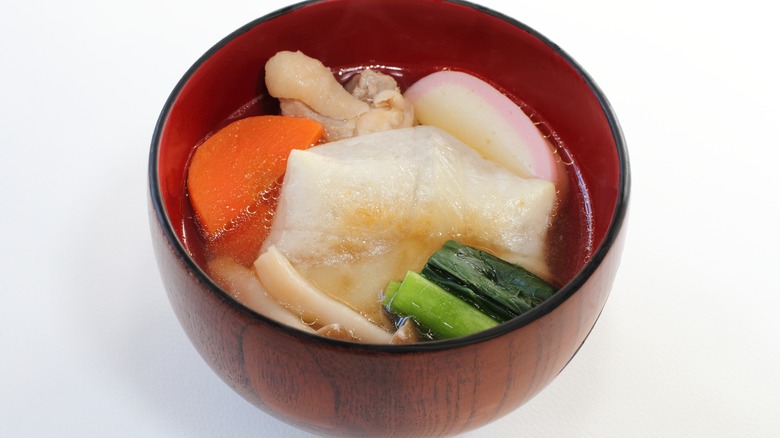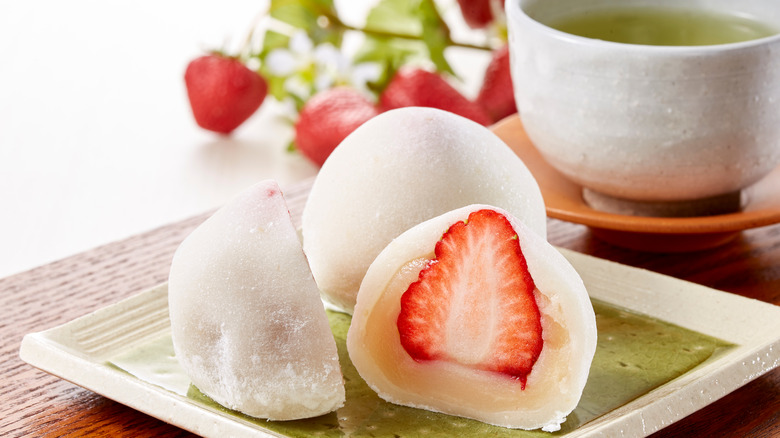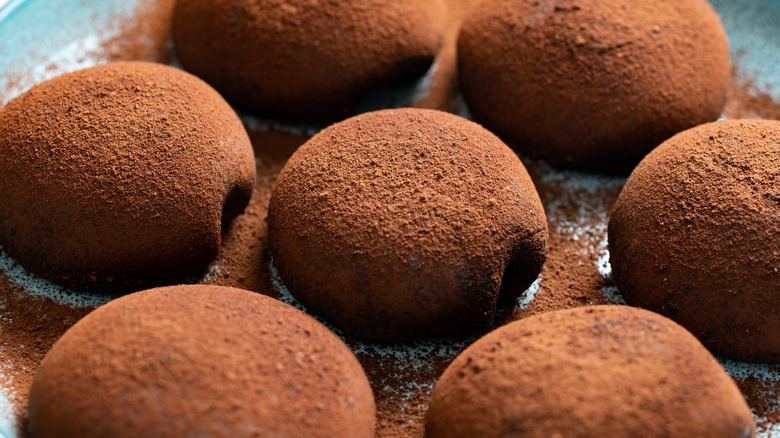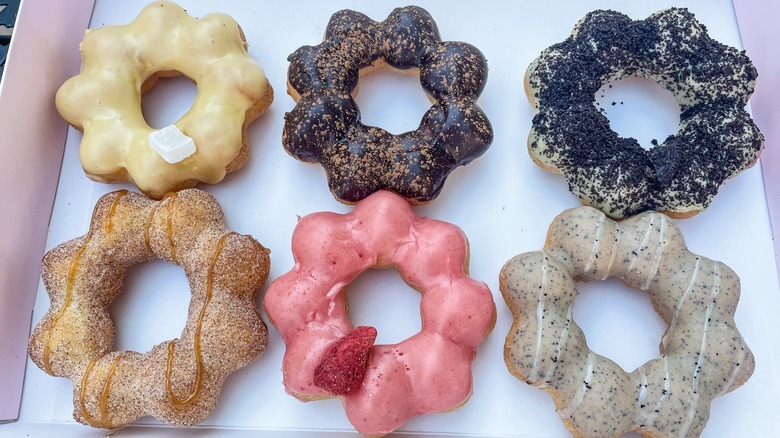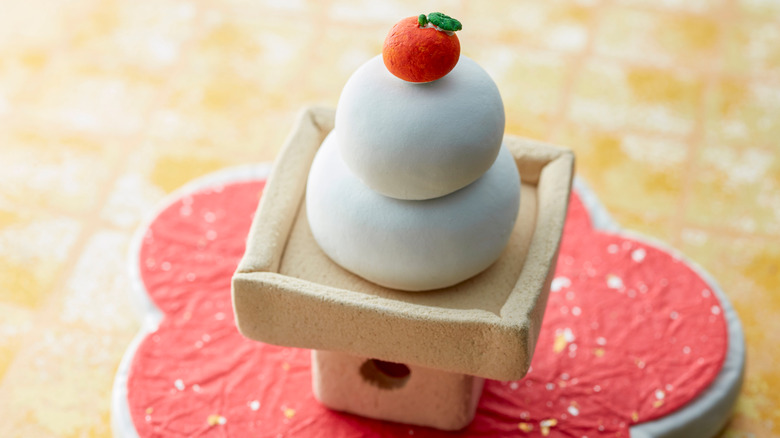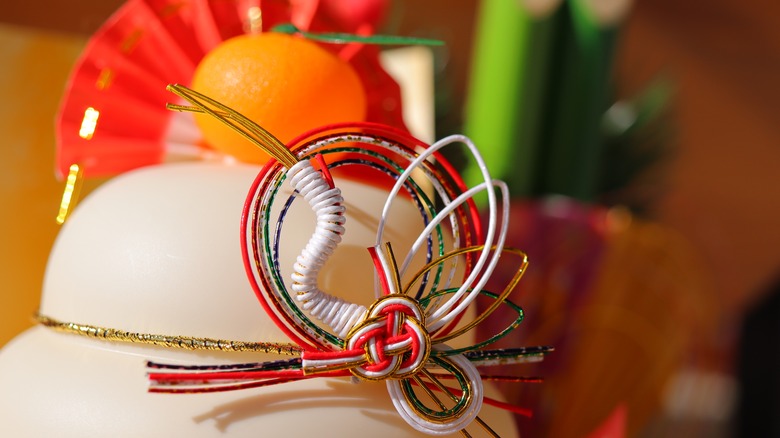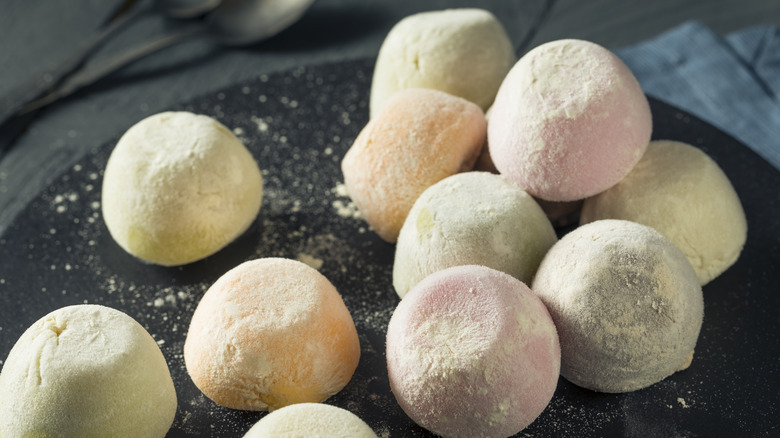The Ultimate Guide To Japanese Mochi
If you are looking for a delightful treat with a satisfying texture, look no further than mochi. These Japanese goodies are traditionally made by pounding a rice concoction until it makes a thin yet chewy dough. Internationally, the most famous type of mochi is probably daifuku, a sweet mochi made by stuffing rice dough with things like red bean paste or ice cream. However, in Japan, the word mochi simply refers to the rice dough itself, not any particular filling. There are tons of different kinds of mochi, in addition to daifuku, out there.
In Japan, you can find plenty of mochi options that don't involve ice cream or sweets. For example, there is yaki mochi, a type of traditional grilled mochi. This iteration of the treat involves heating some rice dough on a grill until it becomes puffy and brown. While you can make yaki mochi into a dessert by adding condensed milk, you can also enjoy it as a savory dish, by eating yaki mochi with butter and soy sauce.
Other types of mochis include sakura mochis — which are wrapped in cherry tree leaves — and kusa mochis — which have mugwort baked into their dough. Because Japanese cuisine offers such a diverse array of mochi preparations and flavors, there is something out there for everyone.
The food is thousands of years old
Mochi may be extremely popular nowadays. But the dessert also has a long and rich history. Rice farming began in Japan around 400 B.C.E., paving the way for mochi (a rice-based food) to be made. Red rice is thought to be the first variety brought to Japan.
The dessert came to have a distinct role in society and culture. During the Nara Period, which took place during the 8th century, mochi was said to have spiritual powers. A text from the period tells the story of a man who made some rice dough, shot it with an arrow, and watched it turn into a bird. The bird then flew away, cursing the surrounding rice fields. The story shows how, during this time, people had a lot of reverence for mochi.
Respect for mochi did not go away. During the Heian period — which took place from the 8th century to the 12th century — people started consuming the treat as a way to usher in the New Year. The practice of eating these traditional New Year's sweets has continued to this day.
It's made from rice
While mochi is known for having a simple flavor, the delightful rice treat isn't easy to make. To prepare mochi the traditional way, cooks start with a chewy variety of glutinous rice called mochigome. Cooks soak this ingredient overnight, then steam it, before starting a mochi-pounding process known as mochitsuki. During this process, two people work together, hammering the mochi dough with a large wooden mallet until it grows soft. One person works the hammer. Their partner turns the rice dough and adds water to the mixture.
These days, most of the mochi that hits the market is produced industrially. It's safe to assume that companies aren't using this traditional method to make their mochi. However, during New Year's festivities, people gather to make mochi the old-fashioned way. The activity is extremely time-consuming and can last for an entire day. To help pass the time, communities will throw mochitsuki festivals. During these events, participants can watch performances, play games, and make mochi.
The treat is often stuffed with ice cream
In 1981, the world of mochi changed forever. That year, the Korean food company Lotte released a brand of mochi-covered ice cream balls to the Japanese market. These delicious mochi ice cream snacks consisted of a rice dough exterior and a dairy-free rice milk interior. They were called yukimi daifuku, which means "snow-viewing dumplings," per SoraNews24. True to its name, the mochi was designed to be enjoyed while watching the snow fall.
The world of mochi ice cream changed dramatically during the 1990s. Then, the Los Angeles bakery Mikawaya introduced mochi to the United States. The business originally offered just three flavors of mochi ice cream: mango, green tea, and red bean. It was a hit, allowing the frozen treats to grow in popularity. Mikawaya is now an international mochi ice cream brand. It sells around a dozen different flavors of mochi ice cream.
As Mikawaya grew as a company, competitors — like My/Mochi Ice Cream — began to emerge. These brands have released flavors that aren't traditionally offered in Japan. This includes s'mores, horchata, and dulce de leche.
Not all mochi is sweet
Despite mochi's international reputation as a dessert item, there are several types of savory mochi enjoyed in Japan. One of them is a soup called ozoni. Another, more pungent iteration of the treat, is called isobeyaki mochi. It involves deep umami flavors. To make, Japanese cooks start by grilling rice dough in a stovetop pan. Next, cooks flavor the mochi with soy sauce. Finally, the whole thing is wrapped in a piece of nori seaweed. Some people even like to add a touch of sugar, making the dish the perfect balance of sweet and salty.
Another similarly savory dish is called karami mochi. Its name translates to "spicy taste mochi." Often topped with soy sauce and nori, this mochi variation includes many of the same elements found in isobeyaki mochi. However, thanks to the addition of the spicy daikon radish, this particular meal can really bring the heat. Chefs change the spice level of this dish by using different parts of the daikon radish.
It is sometimes used to make soup
During New Year celebrations, it is traditional to consume a type of mochi soup called ozoni. Celebrants consume this on New Year's Day, in the morning. The name of this dish essentially means "mixed bowl" in English. It brings together vegetables, miso, and mochi to create a light yet flavorful soup. The recipe for making ozoni varies substantially within Japan. Depending on what region you are in, your ozoni could contain seafood, red beans, radishes, or even fish cakes.
When it comes to ozoni, the biggest difference is between Eastern and Western versions of the soup. The Eastern, or Kanto-style ozoni, is made with a dark brown broth of soy sauce, dashi, and bonito flakes. The Western, or Kansai-style ozoni, is lighter due to its white miso base. To make it, mochi is shaped into squares and then baked, before being added to the soup.
While the rivalry between the two soup styles is strong, some Japanese families have their own unique way of preparing ozoni. Depending on a family's background, location, and taste, they might prepare the soup differently. Some fry, grill, or even roast the mochi used in this soup.
It's now eaten all over the world
Mochi is now eaten all over the world. These treats have become so popular in England that they are reportedly selling out at some supermarkets. In France, more and more mochi shops are opening. In an interview with the Financial Times, mochi store owner Mathilda Motte explained: "Mochi is really bubbling up now. In France, we're seeing shops open in Aix, Lille, Bordeaux, and Paris."
Even as mochi has grown in popularity, some Westerners have found mochi to be an acquired taste. Vivien Wong, the co-founder of the mochi company Little Moons, said the chewy dough was the biggest challenge for some. Speaking to the Financial Times, Wong said: "It's an unusual texture, it takes some getting used to." However, Wong expressed her belief that mochi is becoming more appealing to folks outside of Japan. "But there's a culture shift. People are increasingly accepting the mochi texture. It's like sushi. In the 1990s, people thought it was weird to eat raw fish," she said.
Indeed, it seems that the mochi business is only starting to take off. As per Verified Market Research, the mochi market was worth $345 million at the end of 2021. By 2030, the market is projected to be worth a whopping $423 million.
Certain flavors are common outside of Japan
Although international mochi fandom has been on the rise, people outside of Japan have been hesitant to accept some of the treat's most traditional flavors. In Japan, mochi made with red bean or chestnut cream is popular. But in the rest of the world, consumers are sometimes hesitant to try these flavors. Arthur Saada, founder of the French brand Exquis Mochi, said the issue might be sugar content. Saada explained that traditional Japanese mochi flavors such as red bean are often less sweet than classic Western flavors.
A report by the brand My/Mochi Ice Cream found that its consumers preferred familiar tastes. Red bean mochi is popular in Japan, tiramisu mochi is beloved in Italy, green tea mochi is popular in China, and mango-flavored mochi is a best-seller in India. Based on the country's mochi preferences, the United States is no exception. My/Mochi Ice Cream found that Americans usually go for mochi made with flavors like chocolate and vanilla.
Some types of mochi are not Japanese
Because international mochi companies cater to global tastes, many of them offer mochi varieties that don't exist in Japan. This has resulted in more than one creative mochi interpretation. This includes dochi, a baked good made from a combination of rice dough and donuts. These unique pastries consist of connected and fried mochi. After baking, the treats are often topped with candy, like M&Ms or Twix.
Even the dochi's inventor, Jason Le, admitted that his creation isn't completely Japanese. But he said his invention was designed to be a French version of Japanese mochi. Food products like the dochi represent a new wave of mochi products. This wave is arguably more Western than Japanese.
Some restaurants now sell waffles made out of mochi. These treats perfectly fuse traditional Japanese ingredients with the classic Belgian recipe. In Japan, some businesses are selling Detroit-style pizza made with mochi in the flour. This helps make a crispy and chewy pizza crust.
It's a traditional New Year's treat
Mochi is often consumed during the holidays, especially around the New Year. On New Year's Day, many Japanese families enjoy eating different types of mochi. These include recipes like ozoni, a type of mochi soup. Then, there is kinacho mochi, a treat made with toasted soybean flour. However, kagami mochi is the star of New Year's celebrations. It consists of a two-layer mochi cake. Traditionally, it is served in a unique way. A whole orange is placed on top of the cake, which is then placed on a pedestal.
For many people in Japan, kagami mochis are considered to be hugely symbolic. Their structure — which stacks a smaller mochi above a larger one — represents the intersection of the new year and the old one. In another interpretation, these two spheres can also symbolize the moon and the sun. These planets are called yin and yang. The orange represents the continuation of time. Combined, these elements make kagami mochi a symbol of good fortune for the new year.
If you are ever in Japan around the New Year, do not hesitate to buy some kagami mochis. However, be sure not to throw away the piece of paper that is typically served beneath the cake. This paper is called a shihobeni. In Japanese culture, it symbolizes good fortune for the home. It is believed that these pieces of paper can help prevent house fires.
Kagami mochi is used in unique rituals
The traditional Japanese New Year's treat of kagami mochi was not initially designed for eating. On the contrary, kagami mochis were involved in a long and festive ritual. This ceremony often starts weeks before you can actually serve the treat. Every year in December, people across Japan head to their local supermarkets, convenience stores, and even department stores to pick up a few of these gorgeous white holiday treats. They then proceed to display their kagami mochis in their homes.
While some people prefer to leave their kagami mochis in front of an altar, others choose to leave one treat in each room of their abodes. Either way, most people start setting up their kagami mochis during the days following Christmas. However, there are two days when this never occurs. Nobody decorates their homes with these treats on December 29, because this number sounds similar to the Japanese word for "suffering." Additionally, people are discouraged from setting up their kagami mochis on December 31, as it's not considered fortuitous to decorate at the last minute.
Kagami mochis are only consumed well after the New Year's Day celebrations. This is done during a ritual called kagami biraki. Because these mochis spend so much time as decorations, they become too hard to eat on their own. Instead, the rice cakes are cut up and added to other recipes, such as ozoni or red bean soup.
Anyone can try mochi
If you've never tasted mochi before, the idea of trying it for the first time might seem intimidating. The first thing you'll need to do is try to get accustomed to the ingredient's uniquely stretchy texture. You also might want to start by choosing a flavor that you are familiar with. If you are a huge fan of red bean paste, try buying a traditional daifuku mochi stuffed with red bean paste and fruit. Alternatively, if you are a huge ice cream fan, search for an ice cream mochi in your favorite flavor. This initial stage should help you appreciate mochi's deliciously sticky consistency.
As soon as you feel more comfortable with the traditional mochi texture, you can start experimenting with more complex flavors. Don't be afraid to try ozoni soup or even spicy karami mochi. The more you dive into the world of mochi, the more flavors you will get to explore. If you find that you dislike a particular taste, fear not. Science says that the more you expose yourself to a new flavor, the more quickly you will come to like it. Taste expert Dr. Qian Yang told the BBC that people have to try new foods about a dozen times before they are able to fully appreciate its new flavors.
